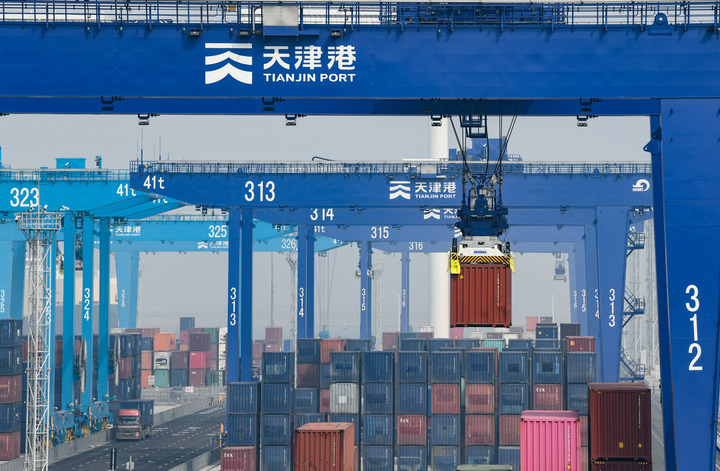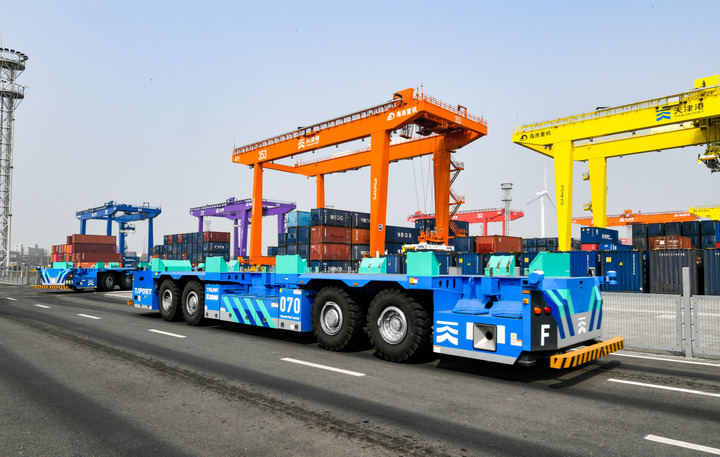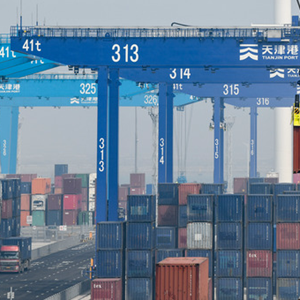The shipping index reveals that the supply chain of China's industrial chain is stable and improved
Author:Xinhua News Agency Time:2022.07.04

On April 9th, in the intelligent container terminal in the C -section of the port area of Tianjin Port, the bridge was lifted in the stacking container. Xinhua News Agency reporter Sun Fanyue Photo
Xinhua News Agency, Tianjin, July 3 (Reporter Wang Ning and Liu Weizhen) In the sea breeze, Tianjin Port, Northern China ushered in a special "guest" -"Viking Sea" rolling ship.
As 660 cars from Dingzhou, Hebei drive to Port Chile in this round, it officially opened a new route with Star South America, and the export channels in the Beijing -Tianjin -Hebei region are even more unblocked.
After the outbreak of the new crown pneumonia, the global sea transport price fluctuated violently, and "a box of hardships" had troubled many trading companies that rely on sea transportation.
What is gratifying is that since this year, a change in an important index shows the development trend of China's supply chain to stabilize.
On June 30, the "vane" of the "vane" of trade prices in northern China -Tianjin Shipping Index (TSI) closed at 1883.11 points, a slight decline of 0.48%from the end of May, a decrease of 3.39%from the beginning of the year, and continued the downward trend. Among them, the northern international container freight index (TCI) closed at 3073.01 points, down 13.37%from the beginning of the year.

On April 9th, in the intelligent container terminal C, the Hong Kong Port area of Tianjin Port, intelligent horizontal transport robots were driving in the yard. Xinhua News Agency reporter Sun Fanyue Photo
The person in charge of the Tianjin International Trade and Shipping Service Center analyzed that the fall of international container freight is the main reason for the decline in TSI. With the general improvement of the epidemic prevention and control situation, the operational efficiency of the shipping supply chain has improved, the main route freight rates have been reduced, and the shipping index has fallen smoothly to release the positive signal of the resumption of the export enterprises to re -production and the steady "recovery" of port transportation.
To the south along the twisted coastline, the situation that tends to be stable in another economy in China, the Yangtze River Delta, is equally clear.
At the fourth phase automation pier of Shanghai Yangshan Shashui Port, the container berth has run at full load, and the 10,000 -ton giant wheels drive to the Haiping Line one after another. In Yangzhou Port, more than 200 kilometers away, 30 pieces of wind power leaves and 173 wind power equipment components were loaded with the "Olun" universal scattered grocery ship, which also drove down into the East China Sea. Earlier, two universal scattered grocery ships were sailed and carried the wind power tower to Australia.
In the hot summer, several major hubs in southern China opened full horsepower and ensured transportation. New ships have also been tried out of the sea. Behind it is the vigorous vitality of industrial enterprises.
According to the weekly statistics released by the Shanghai Shipping Exchange, on July 1, the comprehensive freight freight index of the Shanghai export container was 4203.27 points, which was nearly 20%from 5109.60 points at the highest level at the beginning of the year.
"The trajectory of the shipping index reflects the changes in the container transportation market faced by the enterprise since this year, showing that the contradiction between supply and demand is eased, transportation costs and efficiency are returning to normal." Say.
The shipping index also reflects the development vitality of trade circulation in the coastal areas. Looking around the coast of Liaoning Province, the ports are busy and orderly. The "Dalian -Ningbo" domestic trade routes operated this year set up a new "bridge" for logistics transportation protection, which promoted the economic cycle between the Northeast and the Yangtze River Delta region.
Data show that domestic coastal container freight rates are also relatively stable. At the end of June, the coastal container freight index (TDI) closed at 1520.75 points, an increase of 2.41%from the beginning of the year. The index has returned to the smooth rising channel.
Bo Wenguang, deputy dean of the Binhai Development Research Institute of Nankai University, said that compared with international shipping prices, the domestic trade maritime price curve can better reflect the current cold and warm Chinese economy. The stable shipping index shows that the shipping supply and demand is basically restored to normal, which has important value value for the recovery of the economy in the next stage.
During the epidemic period, China strengthened various methods such as the use of flights and cabin investment in the hub port routes and the production of airline routes at the hub port route, and formulated a variety of methods such as targeted reduction of coastal port quotation fees, and maintained the steady and orderly development of the industrial chain supply chain. Several interviewed industry insiders said that this played an important role in enhancing the vitality of market subject confidence and unblocking domestic and international dual cycles.
From January to May this year, the main international lineup companies exported a total of 9.87 million standard boxes in China. According to data from the National Bureau of Statistics of China, from January to May, the total imports and exports of Chinese goods were 16037.4 billion yuan, an increase of 8.3%year -on -year. China's status in the global industrial chain supply chain is more consolidated.

![]()
[Editor in charge: Wang Jianing]
- END -
Focus on the Twelfth Party Congress of the City | Feng Weihua: Promote the transformation of the industry to the suburbs of high -end transformation to the city
In the report of the Party Congress, it was once again mentioned in depth to promote the coordinated development of Beijing -Tianjin -Hebei. Feng Weihua, the representative of the 12th Party Congres
"Bear Market" focuses on American confidence, economist: US economist may be pushed to "hard landing"
[Global Times special reporter Zheng Ke Global Times reporter Ni Hao Yuwen] The faint light has disappeared and welcome to the bear market -A American media was full of frustration on the 13th. On